Replacing a heater with a cool head
System installation in the timber industry
Skillfully done: That’s the best way of summarizing the work performed by the crane operator, the spotters and the fitters in the Leipzig SCHOLPP team during this project. The company HIT Holzindustrie Torgau GmbH & Co. KG in northern Saxony needed to replace the main component of line 1 of the pellet plant: a heater for timber processing with a total weight of 35 metric tons. The work steps relating to dismantling and reinstallation were rather complex, with large components weighing up to 35 metric tons needing to be moved in the millimeter range. Ultimately, it was a mechanical and well-timed precision landing that wowed the client.
HIT Holz in Torgau is one of the most state-of-the-art sawmills in Germany and is Europe’s largest manufacturer of Europallets. The company’s product range also includes wood briquettes and pellets as well as timber for house, landscape and garden. HIT Holz uses a unique value chain when creating its products: From round logs to the finished product, 100% of the wood is used right down to the very last chip. And the company’s large technical timber-processing plants are just as sophisticated.
The job for SCHOLPP was as follows: Replace a heater in production line 1 of the pellet plant with a total plant weight of 90 metric tons and total dimensions of 10 meters in width, 6 meters in depth and 15 meters in height. The customer wanted the dismantling and reinstallation work to be carried out in as time-saving a manner as possible with minimum disassembly of the large components. The heater line consists of multiple large parts: the heater itself (35 metric tons), an economizer (3-part component, approx. 20 metric tons), the transition piece (32 metric tons) and the furnace. In addition to the heavy weights, the dimensions were also very important factors for the bringing in: the heater measured 4.40 meters in diameter and 9 meters in height; the economizer was 6 meters in height and the upper part was directly connected to the heater via a flue gas hood.
Detailed project planning over five steps
The SCHOLPP engineers worked with HIT to plan the entire project involving the removal and bringing in of the transition piece, the heater and the economizer over five phases. The first phase involved the structural preparation of the building, including the creation of an opening in the hall roof right above the plant. The second phase involved the SCHOLPP team exposing the entire plant. This covered the dismantling of steel structures, pipelines, electrical installations and intermediate and inspection platforms. All of the mechanical steps and the necessary lifting work was carried out by SCHOLPP together with additional partner companies. Phase three involved removing the various components using mobile cranes (100 and 400 metric tons) in the following order: Small components such as pipes, steel beams and inspection platforms, transition piece, then the economizer, additional steel beams and inspection platforms, and finally the heater.
Demanding lifting maneuver using the mobile crane
However, it wasn’t as simple as that, and a number of intermediate steps were required. During the removal phase, some of the components were transverse to the roof opening, meaning that they had to be rotated another 90 degrees in a longitudinal direction inside the hall before being lifted. This was the only way that the parts could fit through the opening for removal via the roof. The economizer was also firstly lifted inside the building and then swiveled relative to the removal opening in the direction of the roof. At many points, there were just a few millimeters between the components being lifted and parts of the building. All of these maneuvers required a lot of skill and precision by experienced crane operators, as well as maximum concentration from the two spotters. The transition piece was temporarily placed on a 4.50-meter-high set-down structure outside the hall made of modular steel staging and steel beams, and was reconditioned for further use.
The various components were brought into the building in phase four, using basically the same processes and crane movements as for the removal. It was only possible to bring in the heater with millimeter precision thanks to the extremely delicate teamwork between the two experienced spotters and the skilled crane operator. The final phase saw the fitters finally reinstall the plant. Over the course of this phase, the steelwork, platforms, pipelines and electrical installations were reinstalled and the roof then closed back up. It took six weeks to complete this project, which had to be divided into these well-planned phases. Technical expertise, proficient logistics and good organization were the deciding factors for the success of this project, and the satisfaction of the client.
High level of client satisfaction secures follow-up order
This was the second project that SCHOLPP had successfully completed for HIT. The SCHOLPP team stood out from the crowd thanks to its wealth of experience, and made such a good impression on the client that a three-person maintenance team was stationed on site straight away. Client satisfaction achieved, further cooperation agreed – now that’s what we call industrial service.
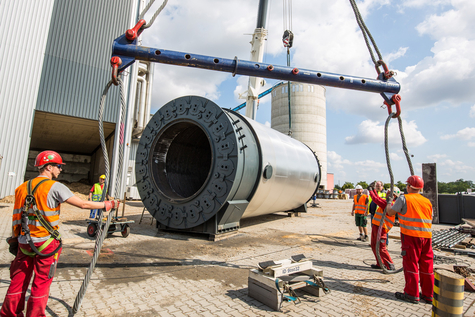
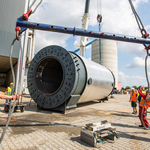
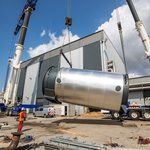
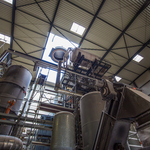
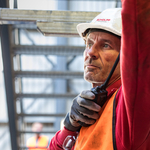
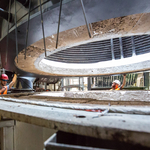
HIT Holzindustrie Torgau GmbH & Co. KG, Torgau/Sachsen
Industry:Power plant engineering
Project type:Rigging projects
Task:Dismantling and reinstallation of a heating system for timber processing (90 metric tons)
Equipment used:Two mobile cranes (100 metric tons and 400 metric tons), assembly container, additional set-down structure consisting of modular steel staging/steel beams (approximate height of the structure: 4.50 meters), articulated boom lifting platform
Unique factors:Extremely delicate collaboration and coordination between the two spotters and the crane operator, removal and bringing in of the heater performed with millimeter precision
Contact person:Want to know more about this project? Please contact us.
